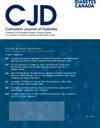糖尿病患者慢性肾病的筛查和诊断:利用加拿大初级保健哨点监测网络开展的一项回顾性队列研究。
IF 2.3
4区 医学
Q3 ENDOCRINOLOGY & METABOLISM
引用次数: 0
摘要
导言:在加拿大,对糖尿病患者慢性肾脏病(CKD)筛查方法的地区性评估强调了需要改进的地方;但是,明显缺乏全国性的评估。对慢性肾脏病发病率的估计通常会忽略与年龄相关的 eGFR 预期下降;年龄适应性阈值可能有助于解释这一点。我们描述了具有全国代表性的初级保健队列中成年糖尿病患者筛查和诊断 CKD 的频率:在这项回顾性队列研究中,我们使用了加拿大初级医疗哨点监测网络(CPCSSN)的电子病历数据。从 2014 年开始,我们对基线为无慢性肾脏病的成年糖尿病患者(18 岁以上)进行了为期 5 年的跟踪调查。我们确定了随时间推移进行 ACR 和/或 eGFR 检测的频率。我们使用固定阈值和年龄适应性定义,根据 eGFR 测量结果确定了 CKD 诊断事件,并量化了发病比例和发病率:我们分析了 37 604 名糖尿病患者的记录。只有 13% 的患者每年进行一次 eGFR 和 ACR 检测,以确定是否患有 CKD,但大约 60% 的患者在 5 年内没有每年进行这两项检测。eGFR 检测的频率高于 ACR 检测(94.1% 的患者在随访期间进行过检测,而 76.6% 的患者在随访期间进行过检测)。我们发现,与年龄适应性定义相比,使用固定阈值的 CKD 发病率(14.6% 对 6.0%)和诊断率(33.1 对 13.4/1000 人-年)均有所上升:我们的研究首次在全国范围内了解了加拿大糖尿病患者的 CKD 筛查情况。我们的研究首次在全国范围内了解了加拿大糖尿病患者的慢性肾功能衰竭筛查方法,特别是应鼓励更多地使用 ACR 检测来早期发现肾功能的变化。本文章由计算机程序翻译,如有差异,请以英文原文为准。
Screening and Diagnosis of Chronic Kidney Disease in Adults Living With Diabetes: A Retrospective Cohort Study Using the Canadian Primary Care Sentinel Surveillance Network
Objectives
In Canada, regional evaluations of screening practices for chronic kidney disease (CKD) among people with diabetes highlight areas for improvement; however, national estimates are notably absent. Estimates of CKD incidence often discount the expected decline in estimated glomerular filtration rate (eGFR) associated with age; age-adaptive thresholds may help account for this. We describe the frequency of screening and diagnosis of CKD among adults with diabetes from a nationally representative primary care cohort.
Methods
In this retrospective cohort study, we used electronic medical record data from the Canadian Primary Care Sentinel Surveillance Network. We followed adult patients (≥18 years of age) with diabetes without CKD at baseline for 5 years starting in 2014. We determined the frequency of urine albumin-to-creatinine ratio (uACr) and/or eGFR testing over time. We identified incident CKD diagnoses based on eGFR measurements using fixed-threshold and age-adaptive definitions and quantified the incidence proportion and rate.
Results
We analyzed records from 37,604 patients with diabetes. Only 13% of patients had yearly eGFR and uACr testing for CKD, although roughly 60% had non-yearly use of both tests in 5 years. eGFR testing was performed more frequently than uACr testing (94.1% vs 76.6% having testing over follow-up). We found increased incidence proportions (14.6% vs 6.0%) and rates (33.1 vs 13.4 diagnoses per 1,000 person-years) of CKD using the fixed-threshold compared with age-adaptive definition.
Conclusions
Our study presents the first national understanding of screening practices for CKD among people with diabetes in Canada. Specifically, increased use of uACr testing should be encouraged for early detection of changes in kidney function.
求助全文
通过发布文献求助,成功后即可免费获取论文全文。
去求助
来源期刊

Canadian Journal of Diabetes
ENDOCRINOLOGY & METABOLISM-
CiteScore
4.80
自引率
4.00%
发文量
130
审稿时长
54 days
期刊介绍:
The Canadian Journal of Diabetes is Canada''s only diabetes-oriented, peer-reviewed, interdisciplinary journal for diabetes health-care professionals.
Published bimonthly, the Canadian Journal of Diabetes contains original articles; reviews; case reports; shorter articles such as Perspectives in Practice, Practical Diabetes and Innovations in Diabetes Care; Diabetes Dilemmas and Letters to the Editor.
 求助内容:
求助内容: 应助结果提醒方式:
应助结果提醒方式:


